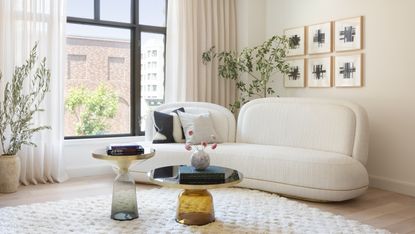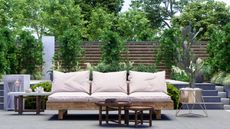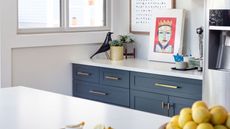Are curtains out of style? Top interior designers on how to choose them now and what to use instead
We ask the tastemakers if curtains are still on-trend – and how to work them in a contemporary scheme


As far as window dressings go, it’s fair to say that curtains have been a staple over the years – centuries, even. From ornate Italian Renaissance designs to luxurious velvet, floaty linen and – of course – infamous grandmother-style nets, this window dressing has proven itself to be a versatile addition to the home – but one that’s often divisive, too.
That leaves us questioning: are they the interior design trend we need in 2024? ‘Curtains, and their ability to shade, protect and shield, are a home item as old as time,’ says interior designer Allison Knizek of Allison Knizek Design. ‘Fabric drapes and curtains can fade, collect dust, and even disintegrate after years of use, especially when exposed to the sun. With sleeker window coverings now available to all, many think of this interior design category as heavy, dated and out of style – but I’m happy to tell you otherwise!’
Of course, curtains serve a practical purpose as well as a style-led one: they keep artificial light from disturbing you at night, can help reduce overheating during the summer, and reduce heat loss up to 10 percent in winter, according to the US Department of Energy. But with good-looking alternatives such as blinds, shutters and shades, are curtains a dated trend – or a way of personalizing and softening a scheme? We spoke to interior designers to get their thoughts – and spoiler alert: it looks like it’s not over for curtains just yet.
So, are curtains out of style?
Used for centuries to provide privacy and shield from sunlight and poor weather, curtains have a rich history in interior design. The heavy fabrics and ornate designs used during the Victorian era – where velvet, silk and brocade reigned supreme – made way for natural textiles like cotton, linen and wool, as well as a more functional style, in the 20th century. Meanwhile, the Arts and Crafts movement brought curtain hardware – like hooks, rings and finials – firmly into the design spotlight.
Today’s offering means there’s something for everyone – but to some, the style of curtain that comes to mind is still heavy, overbearing and outdated. To interior designer Anne Hepfer, author of upcoming book MOOD, that’s all down to the fabric. ‘Using heavy fabrics for curtains can make the home feel dated and stuffy,’ she says. ‘I also don’t like shiny fabrics.’

Interior designer Lisa Sherry, of Lisa Sherry Interieurs, agrees. ‘I love a surplus of windows and sunlight and I don’t want anything to get in the way,’ she says. ‘That said, in my practice, it’s not entirely curtains for curtains. Windows shrouded in heavy textiles replete with swags and jabots feel oppressive and dated – but in many instances, draperies can buffer a so-so view and are often needed for privacy and light management. Free the curtain, I say!’
‘In a super modern environment with white walls, even if you go with white fabric, drapes can add a layer of softness and texture,’ says interior designer Julie Assenberg. ‘In a more traditional setting, drapes are always at home and are an opportunity to add color and pattern. Besides being a design feature, they’re also functional: they can block sunlight if you use a blackout lining. They can also absorb sound and help with noise.’
The answer, then, isn’t that curtains are out of style – it’s just that we need to revisit how we use them as modern window treatments. ‘I see curtains and drapes as the “hairdo” of the room,’ says Allison Knizek. ‘They bring a soft and drapey element to a space and add a dramatic element of height, lifting the eye regardless of the ceiling height.’
How do you make curtains look contemporary?
‘Curtains can really make or break a room,’ says Julia King, founder and principal designer of San Francisco and Los Angeles-based Studio Roene. To avoid feeling dated, she recommends paying attention to the details: 'Choose a casual material like linen, cotton, or a thin wool blend. These materials are light and won’t weigh the room down. A subtle pattern or a solid color always looks nice. A little bit of trim could look chic, but use this as an accent and not the main feature.’
King also recommends opting for a reverse pleat or single pinch pleat, which work with any style – and choosing the simplest rod style. ‘No large curly finials or crystal balls – too much unnecessary detail makes them feel old,’ she says. ‘If you’re using a track system, make sure it’s recessed and matches the ceiling color.’

Anne Hepfer agrees that cotton, linen and wool are better for a modern look – and argues the case for pattern. ‘Depending on the style of the space, pattern can add a personality,’ she says. ‘I love horizontal stripes, wool plaids for cozier spaces, and sometimes luxurious embroidered fabrics.’ Sometimes curtain hardware doesn’t need to be seen, either: ‘For more contemporary spaces, we sometimes eliminate drapery hardware and add a concealed architectural track in the ceiling.’
'Generally keeping it simple and refined will create a modern and sophisticated look,' agrees Davina Ogilvie, founder of Wovn Home. 'Linens or linen blends have wonderful draping qualities, and look updated and modern while also being a very durable fabric. Small and medium scale floral patterns blend in more easily in modern style homes, while larger scale toile prints can still look fresh in vibrant color combinations.'
Paying attention to the era of your property makes a difference, too. ‘Many of our projects are within very special, storied buildings that were structured by famed architects and designers,’ says Guillaume Coutheillas, founder and creative director of frenchCALIFORNIA. ‘We always want our interior design to pay homage and nod to their work, while still adding a modern, liveable touch to the space. When it comes to window treatments and drapery, we want to choose styles and fabrics that complement and blend into the existing architecture, whether that means choosing subtle colors like beige, cream and tan, or textures that blend seamlessly into the space, like linen. With a seamless window treatment, we are also ensuring that we provide a framework for the view from the building, rather than acting as a distraction.’
How you hang curtains also makes a huge difference to how they feel. ‘Ideally, curtains should sit just a tiny fraction above the floor for a cleaner look,’ says Julia King of Studio Roane. ‘Curtains that are way too short look like a bad mistake, and overly long curtains that drag too much feel very heavy. Always hire a professional, if possible, who can make sure hardware is mounted at the right height. They can also re-hem the curtains if they need to be adjusted.’

With all that in mind, what curtain trend are the designers loving right now? ‘Belgian linen is my heartthrob go-to for all things curtains and window treatments,’ says Lisa Sherry. ‘Linen and light play beautifully together. Whenever possible, I prefer no lining – it restricts the fabric. When light management and privacy are factors, I’ll specify roller Roman shades. And curtains aren’t just for windows. I love portieres: billowing swaths of fabric can frame a large doorway, define a space and add drama. Windows and curtains are not always a twinset!’
‘Nothing makes me happier than using very high-quality fabric, custom hardware and a detailed tape trim to pull it all together,’ says Anne Hepfer. ‘The lining can also have a big impact on weight and feel. If the curtain can be seen outside of the window we’ll also consider a contrasting fabric as a liner.'
'I love seeing more use of cafe curtains and sink skirts,' says Davina Ogilvie. 'These trends can be very practical and functional, and with lighter weight linen fabrics look more modern than your grandmother's version. I'm also excited to see the use of more trim in window treatments. Something simple like a grosgrain ribbon trim along the edge of a curtain panel can make a big punch!'
What are the alternatives to curtains?
If you're not convinced curtains are for you, there are plenty of other bedroom and living room window treatments to dress up your windows and provide privacy. Roman blinds are a sleek and stylish staple that can be adapted to your scheme; opt for a design in soft linen for the same texture-making effect that curtains can bring.
Roller blinds, especially blackout blinds, are ideal for bedrooms as they'll keep the space dark while you're sleeping – but it's worth pairing them with a lighter curtain, like a voile, to soften their harder edges. Or opt for solid wood shutters for a classic look that also guarantees a good night's sleep.
Our view? There's always a place for curtains in the home – but in most cases, it seems lighter and softer is the way to go.
Be The First To Know
The Livingetc newsletter is your shortcut to the now and the next in home design. Subscribe today to receive a stunning free 200-page book of the best homes from around the world.

Ellen is deputy editor of Livingetc magazine. She cut her teeth working for sister publication Real Homes, starting as features editor before becoming deputy editor. There, she enjoyed taking a peek inside beautiful homes and discovered a love for design and architecture that eventually led her here. She has also written for other titles including Homes & Gardens and Gardeningetc. While she gets ready to buy a house of her own, she takes inspiration from the works of some of her favourite architects and tastemakers. She has a particular passion for green design and enjoys shopping small, local and second-hand where she can.
-
 5 Trees You Should Prune in Your Backyard in February — 'It Makes Much Sense to Cut These Ones Back Now'
5 Trees You Should Prune in Your Backyard in February — 'It Makes Much Sense to Cut These Ones Back Now'If you think pruning trees is best left to spring, think again. These trees all could use some cutting back now for several very important reasons
By Hugh Metcalf Published
-
 The 4 Things People With Really Organized Kitchen Drawers Always Have
The 4 Things People With Really Organized Kitchen Drawers Always HaveLevel up your ‘drawer decor’ and keep things tidy and organized with these 4 essential ideas for uncluttered storage
By Becca Cullum-Green Published

